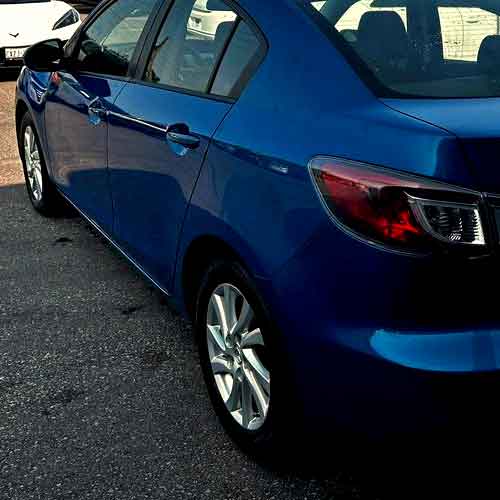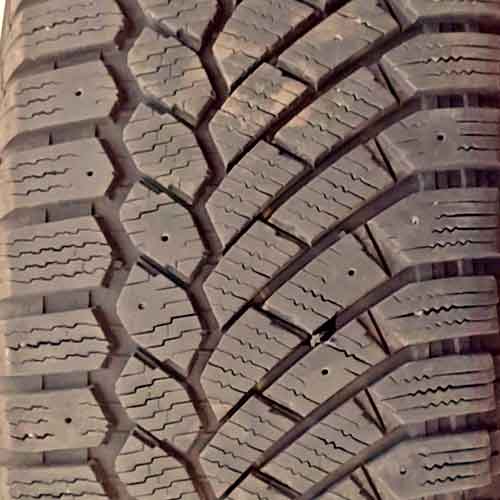Both Gislaved Nordfrost 200 and the Nordfrost 100, are great options, where the updated model offers better and more unique capabilities, especially when it comes to traction and handling. Let’s check out the difference on both.

Table of Contents
Key Takeaway
The Gislaved Nordfrost 200 excels in:
- Wet Traction: The tire dominates in hydroplaning resistance with better grooves, and in wet grip due to its unique tread design with multi-angled sipes and a blend of rectilinear and interlocking patterns.
- Snow Performance: The tire has been engineered with an optimal tread pattern that fosters enhanced snow-to-snow contact. This is further facilitated by its asymmetric tread design.
- Tread Life: The Gislaved Nordfrost 200 benefits from a greater tread depth (by 2/32″ across all sizes), which leads to extended tread life.
On the other hand, the Gislaved Nordfrost 100, even though is the older model, still excels in the following.
- Ice Performance: Despite the advancements of the Nordfrost 200, the Nordfrost 100 still reigns supreme in icy conditions, with its more thermally adaptive rubber compound.
- Comfort Levels: The Nordfrost 100 manages to deliver a similar level of comfort as its successor.
- Fuel Economy: The Nordfrost 100’s lighter weight and shallower tread depth contribute to lower rolling resistance, allowing for better mpg readings.
Info on Sizes
| Specifications | Gislaved Nordfrost 200 | Nordfrost 100 |
|---|---|---|
| Wheel Size (inches) | 14 to 19 | 13 to 17 |
| Speed Ratings | T only | T only |
| Load Ratings | SL and XL | SL and XL |
| Tread Depth | 10/32″ | 8/32″ |
| Weight (lbs.) | 15 to 35 | 15 to 25 |
| Tread Warranty | None | None |
Wet Traction
The ability of a tire to maintain traction on wet surfaces relies largely on two critical factors: grip and resistance to hydroplaning.

And here, observations from our analysis reveal a blend of strengths and weaknesses across both tires in this regard.
The Gislaved Nordfrost 200 excels in the grip category, where it’s dominance is owing to its unique tread design, characterized by multi-angled sipes and a combination of both rectilinear and interlocking patterns.
These design elements serve a crucial function: they guide in multiple directions and vacuum up the water particles, clearing the way for the remaining tread rubber to establish a solid grip. This is the science behind the working of sipes, which create a vacuum effect, that naturally draws in water particles.
On the flip side, the Gislaved Nordfrost 100 comes equipped solely with less effective siping and lacks the rectilinear pattern of its slits. As a result, it doesn’t secure as much grip.
Moreover, the tire also lacks with it comes to resistance to aquaplaning, which is the phenomenon where a tire begins to skim over water rather than making contact with the road surface.
Basiaclly the Nordfrost 100 had a huge problem, where it’s tread depth of only 8/32″ does not offer water enough room to move out.
Now the updated model comes with better channels, for water to escape and a tread depth of 10/32″, meaning more volume of water goes out in a given time.
So overall The NordFrost 200 excels in both wet grip and resistance to aquaplaning.
Snow Performance
In the face of diverse snowy conditions, both tires showcased commendable performance, indicating their capacity to tackle winter’s challenges. Though the newer is better here as well.
This slight edge can be attributed to its unique tread pattern. Even though the predecessor features good enough biters, NordFrost 200 still feature lugs which create a more optimal, and enhanced snow-to-snow contact.
While the loosely packed snow is scooped up more effortlessly by the tire’s interlocking grooves and snow-trapping recesses.
Once captured, the snow forms a bond between the tire and the road, thereby offering superior traction. This is based on the principle that snow adheres better to other snowflakes than to rubber.
And yes, the tire’s better asymmetric tread further adds to that, (the predecessor had directional pattern).
So overall, the Gislaved Nordfrost 200 seems to shine brighter than its predecessor.
Tread Life
A significant factor that determines the lifespan of a tire’s tread is its rolling resistance. In this regard, the Gislaved Nordfrost 200 again comes on top.
And that’s mainly because of the tire’s tread depth.
I mean even though the newer tire is heavier, that produces greater rolling friction, (as lugs have more burden on them, as they rub against the surface of the ground), its still saved by its tread depth.
Basically the updated model comes with 2/32″ greater tread depth on all sizes, and that’s the main reason, why NordFrost 200 takes more time to reach down to replacement tread depth levels.
Though you still don’t get any treadwear warranty with the newer model, just like before.
So in essence, NordFrost 200 offers longer tread life, comparatively, where the predecessor lacks with its softer compound and shorter tread depth.
Ice Performance
But with softer comopund, the previous model does offer better ice gripping, in comparison. But why is that happening? Shouldn’t the newer model be improved in this scenerio?
Well, it depends on what the tire is aiming at. Let me explain.
So one of the major issues with Gislaved Nordfrost 100 was its lacking tread life. I mean it was one of the fastest wearing tire in its category.
So with the newer tire, the Gislaved really wanted to improve that aspect, and as already expalined in the tread life section, they did.
But it came at a cost of not having just as good ice traction. I mean its still okay, but it’s not enough to outperform its previous model.
Now sure, both tires have complex tread biter arrangements, where they offer/offered central rib features slanted cuts of varying widths, dual-directional V-shaped notches, and a rich supply of sipes, all contributing to ice grip.
But the main issue is that the newer tire is not as relatively soft. Or in other words, the rubber is not as thermally adaptive as it was before.
And that’s why with harsh freezing temparatures, the newer model’s tread tends to get more stiffen up, and the biters loose their biting efficacy.
So the NordFrost 100 takes the lead here.
Comfort Levels
The comfort afforded by a tire is a function of several factors, such as road noise and vibration absorption. And here, the tire’s design, the materials used, the tread pattern, and sidewall structure all influence these aspects.
Now, when it comes to noise, you should know that it primarily originates from air particles colliding with the tread walls.
And understanding that, it makes sense why the Gislaved Nordfrost 100 provides just as quiet ride compared to the newer model.
Basically this tire with less rubber, offers air, less area to strike, keeping noise at bay. Whereas the newer tire doing the opposite should create more noise, but its saved by it’s superior tread creating a better pitch design. So there’s less in-groove resonance.
Meaning, both tires end up with similar scores, when it comes to noise.
And same is going on, in terms of impact comfort, which has to do with bumps absorption.
The previous model is softer, but since it has less tread depth in comparison, its performance is just as good as the newer model.
So overall comfort performance on both tires is surprisingly same.
Fuel Economy
Fuel consumption is influenced by the tire’s adhesion to the road and its overall structural weight.
In this aspect, the Gislaved Nordfrost 100 outperforms due to its lighter weight, and shallower tread depth, which results in lower rolling resistance values. Moreover, the streamlined central rib on the tire further adds to that, allowing for smoother tire rolling.
(With streamlined lugs, I’m referring to its directional pattern, which is now changed to asymmetrical, on the newer tire).
On the other hand, the Gislaved Nordfrost 200 struggles due to its significant weight, which basically causes lugs to deform more, significantly during cornering, generating heat and wasting energy that could have been used to propel the tire forward.
So you get better mpg, and thereby fuel economy on Gislaved Nordfrost 100, even though its an older tire.
Verdict?
In a comprehensive evaluation spanning various conditions and parameters, the Gislaved Nordfrost 200 consistently outperforms its predecessor, especially in the domains of wet traction, snow performance, and tread life.
While NordFrost 200’s advancements in tread design and depth lend it enhanced wet grip, superior snow-to-snow contact, and an extended lifespan.
Though the tire still is better in terms of ice performance and fuel economy, primarily due to its softer compound and lighter weight.
As for comfort, both tires astonishingly match each other in attributes like noise reduction and impact absorption, culminating in an almost identical riding experience.
Summarily, while the Nordfrost 200 emerges as the more evolved variant in most categories, the NordFrost 100 retains specific strengths, particularly in icy conditions and fuel efficiency.